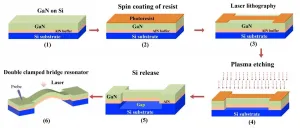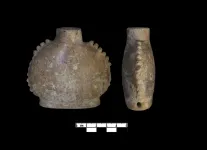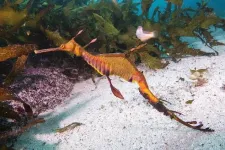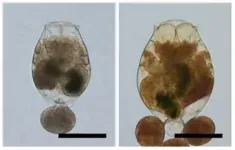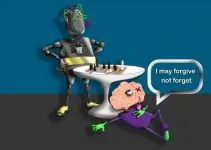Towards applications: ultra-low-loss on-chip zero-index materials
2021-01-15
(Press-News.org) A refractive index of zero induces a wave vector with zero amplitude and undefined direction. Therefore, light propagating inside a zero-index medium does not accumulate any spatial phase advance, resulting in perfect spatial coherence. Such coherence brings several potential applications, including arbitrarily shaped waveguides, phase-mismatch-free nonlinear propagation, large-area single-mode lasers, and extended super radiance. A promising platform to achieve these applications is an integrated Dirac-cone material that features an impedance-matched zero index. However, although this platform eliminates ohmic losses via its purely dielectric structure, it still entails out-of-plane radiation loss (about 1 dB/μm), restricting the applications to a small scale.
In 2018, Professor Shanhui Fan's research group at Stanford University designed a low-loss Dirac-cone zero-index material based on symmetry-protected bound states in the continuum (BICs). However, this Dirac cone is consisted of high-order modes, thus it is challenging to homogenize the photonic crystal slab as a bulk zero-index medium.
In a new paper published in Light Science & Application, a team of scientists, led by Professor Yang Li from the Department of Precision Instrument at Tsinghua University, China, Professor Eric Mazur from the John A. Paulson School of Engineering and Applied Sciences at Harvard University, the US, Professor Weiguo Chu from Nanofabrication Laboratory at the National Center for Nanoscience and Technology, China, and co-workers achieved a zero-index design based on a purely dielectric photonic crystal slab (PhC slab). This design supports an accidental Dirac-cone degeneracy of an electric monopole mode and a magnetic dipole mode at the centre of the Brillouin zone. Such low-order mode-based design can be better treated as a homogeneous zero-index medium.
Their design consists of a square array of silicon pillars embedded in silicon dioxide background matrix, featuring an easy fabrication using standard planar processes. To reduce the radiation loss, they model the top and bottom interfaces of a zero-index PhC slab as two partially reflective mirrors to form a Fabry-Pérot (FP) cavity. Then, they adjust the thickness of this FP cavity to induce destructive interference of upward (downward) radiations in the far field. Inside each pillar, there are axially propagating mode(s) with dipole symmetry showing a round-trip phase of an integer multiple of 2π, therefore becoming resonance-trapped modes. The monopole mode does not radiate in the out-of-plane direction because of its intrinsic mode symmetry.
"Our design exhibits an in-plane propagation loss as low as 0.15 dB/mm at the zero-index wavelength. Furthermore, the refractive index is near zero (|neff| < 0.1) over a bandwidth of 4.9%." Tian Dong declared.
For applications, Yueyang Liu predict: "our on-chip BIC Dirac-cone zero-index PhC slabs provide an infinite coherence length with low propagation loss. This opens the door to applications of large-area zero-index materials in linear and nonlinear optics as well as lasers. For examples, electromagnetic energy tunnelling through a zero-index waveguide with an arbitrary shape, nonlinear light generation without phase mismatch over a long interaction length, and lasing over a large area in a single mode."
"This work can also serve as an on-chip lab to explore fundamental quantum optics such as efficient generation of entangled photon pairs and collective emission of many emitters. Particularly, because the spatial distribution of Ez in each silicon pillar oscillates between a monopole mode and a dipole mode as time elapses, all the quantum emitters within the pillars will experience the same spatial phase in the monopole half cycle. This significantly alleviates the challenge of precise positioning of quantum emitters in a photonic cavity." Yueyang Liu added.
INFORMATION:
[Attachments] See images for this press release:

ELSE PRESS RELEASES FROM THIS DATE:
2021-01-15
The development of ultrafast all-optical switches has long been a popular topic in photonics, while the speed of magnetization reversal triggered by means other than magnetic fields has recently attracted intense interest in spintronics. The discovery of all-optical helicity-dependent switching in metallic GdFeCo has promised a merger of the fields of photonics and spintronics, paving the way for faster and more energy-efficient information processing technologies. However, the real potential of all-optical switching is still poorly understood because it is still unclear whether magnetic switching by light can keep up with the GHz frequencies required by photonics technologies. ...
2021-01-15
"The lotus roots may break, but the fiber remains joined" is an old Chinese saying that reflects the unique structure and mechanical properties of the lotus fiber. The outstanding mechanical properties of lotus fibers can be attributed to their unique spiral structure, which provides an attractive model for biomimetic design of artificial fibers.
In a new study published in Nano Letters, a team led by Prof. YU Shuhong from the University of Science and Technology of China (USTC) of the Chinese Academy of Sciences (CAS) reported a bio-inspired lotus-fiber-mimetic spiral structure bacterial cellulose (BC) hydrogel fiber with high strength, ...
2021-01-15
Liwen Sang, independent scientist at International Center for Materials Nanoarchitectonics, National Institute for Materials Science (also JST PRESTO researcher) developed a MEMS resonator that stably operates even under high temperatures by regulating the strain caused by the heat from gallium nitride (GaN).
High-precision synchronization is required for the fifth generation mobile communication system (5G) with a high speed and large capacity. To that end, a high-performance frequency reference oscillator which can balance the temporal stability and temporal resolution is necessary as a timing device to generate signals ...
2021-01-15
PULLMAN, Wash. - Scientists have identified the presence of a non-tobacco plant in ancient Maya drug containers for the first time.
The Washington State University researchers detected Mexican marigold (Tagetes lucida) in residues taken from 14 miniature Maya ceramic vessels.
Originally buried more than 1,000 years ago on Mexico's Yucatán peninsula, the vessels also contain chemical traces present in two types of dried and cured tobacco, Nicotiana tabacum and N. rustica. The research team, led by anthropology postdoc Mario Zimmermann, thinks the Mexican marigold was mixed with the tobacco to make smoking more enjoyable.
The discovery of the vessels' contents paints a clearer picture of ancient Maya drug use practices. The research, which was published ...
2021-01-15
Partially protected areas - marine reserves that allow some forms of fishing - are no more effective socially or ecologically than open marine areas in Australia's Great Southern Reef, a new UNSW study has concluded.
The research, published in Conservation Biology today, comes at a time when the High Ambition Coalition of 50 countries of the world (which does not include Australia) have pledged to protect more than 30 per cent of the planet's lands and seas by the end of this decade. But not all protected areas are created equal.
The UNSW study discovered partially protected areas in southern Australia had no more fish, invertebrates or algae and no difference in ...
2021-01-15
Researchers from Kumamoto University (Japan) have found an Edo period document that clearly indicates the Hosokawa clan, rulers of the Kokura Domain (modern-day Fukuoka Prefecture), completely stopped producing wine in 1632, the year before the shogunate ordered them to move to the Higo Domain (now Kumamoto Prefecture). The researchers believe that the discontinuation of wine production was directly related to this move and because it was considered to be a drink of a religion that was harshly suppressed in Japan at that time, Christianity.
Previous analysis of historical documents revealed that the lord of the Hosokawa clan, Tadatoshi Hosokawa, ordered wine production from 1627 to 1630 for medicinal use. His ...
2021-01-15
Divergences between scientific and Indigenous and Local Knowledge can provide a better understanding of why local pastoralists may be willing, or not, to participate in conservation initiatives for carnivores, a study from University of Helsinki suggests.
Carnivore conservation has historically been based primarily on scientific knowledge using a wide range of sampling methods, such as camera trapping and track surveys. However, the estimates of these common ecological sampling methods can be quite uncertain and can depend on accessibility and geology, which is the case of many remote areas, such as Sibiloi National Park in Northern Kenya. For this reason, the inclusion of local communities that share ...
2021-01-15
A research team led by scientists at the RIKEN Nishina Center for Accelerator-Based Science (RNC) has successfully created larger-than-usual strains of zooplankton -- which are used in fish nurseries -- by creating mutations with a heavy ion beam. The new strains of zooplankton could contribute to improving the survival rate and optimizing the growth of juvenile fish in aquaculture.
Economically important fish species, such as bluefin tuna, yellowtail, flatfish and groupers, are fed live bait until they are large enough to be fed with artificial foods. ...
2021-01-15
Any building project requires the formulation of a series of initial plans prior to starting construction to serve as a basis and guide for the whole process. A similar procedure is followed in software development, with the inclusion of a specific step known as modelling. "The process is equivalent to the production of a set of plans for a building before its construction," explained Universitat Oberta de Catalunya (UOC) Faculty of Computer Science, Multimedia and Telecommunications professor and member of the SOM Research Lab research group -from the Internet Interdisciplinary Institute (IN3)-, Robert Clarisó.
Engineers use modelling to describe ...
2021-01-15
In the last decades, Artificial Intelligence has shown to be very good at achieving exceptional goals in several fields. Chess is one of them: in 1996, for the first time, the computer Deep Blue beat a human player, chess champion Garry Kasparov. A new piece of research shows now that the brain strategy for storing memories may lead to imperfect memories, but in turn, allows it to store more memories, and with less hassle than AI. The new study, carried out by SISSA scientists in collaboration with Kavli Institute for Systems Neuroscience & Centre for Neural Computation, Trondheim, Norway, has just been published in Physical Review Letters.
Neural networks, real or artificial, learn by tweaking the connections ...
LAST 30 PRESS RELEASES:
[Press-News.org] Towards applications: ultra-low-loss on-chip zero-index materials


